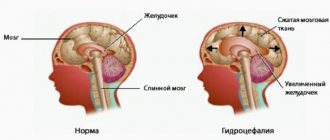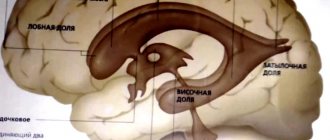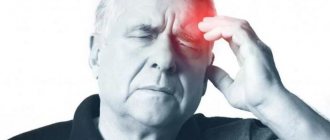A serious pathology associated with brain function is venous congestion in the head. There are many reasons for this problem; it can be either disturbances in the outflow of blood in the head and neck area or diseases of the internal organs. The manifestations of venous stagnation are also varied, for example, constant heaviness in the head, headache, nausea, weakness, dizziness, fainting and even convulsions. The process of blood circulation in the brain is arranged in a special way. Once in the capillaries, the blood supplies the tissues with oxygen and nutrients, and then enters the veins, which flow into the sinuses (venous sinuses). The volume of these sinuses is designed for a larger volume of blood. The vessels themselves also play an important role in the regulation of venous outflow. On their surface there are receptors that actively react when too much blood enters. A signal is transmitted to the brain that it is necessary to increase the lumen of the veins. Thus, blood flow improves and pressure drops. Treatment of the brain begins only after identifying the causes of symptoms and carrying out the necessary diagnostic measures.
Cerebral circulation
The brain accounts for only 2% of the mass of the entire body, and it consumes from 10% of energy even at rest - and up to 25% during periods of powerful intellectual activity. The outflow of metabolic products is no less important than nutrition. But if impaired blood supply is associated with obvious and often fatal dysfunctions, then venous congestion does not make itself felt for a long time and manifests itself in the form of protracted illnesses that greatly worsen the quality of life. If pathology is ignored for a long time, the consequences become irreparable.
Osteopathy considers any symptoms as a sign that something is wrong with the body; diagnosis and correction are needed. Especially when it comes to migraines, drowsiness, and feelings of powerlessness.
Osteopathic doctors have perfect knowledge of the anatomy and functionality of the blood vessels of the brain, thanks to which they determine the location of the “breakdown”. Every detail matters.
There are deep and superficial veins of the brain and venous sinuses of the dura mater. The first pass through the thickness of the white matter and collect processed blood directly from it, as well as the hemispheric nuclei, thalamus, and choroid plexus of the brain.
Venous vessels located on the surface are responsible for draining blood from the cerebral cortex and cerebellum.
The sinuses, paired and unpaired, are formed by splitting the brain membrane and represent some kind of reservoirs into which waste blood enters before exiting into the external venous drainage of the skull.
Since the sinuses are containers with dense walls that are almost not subject to deformation, they seem to protect flexible elastic vessels in the process of blood outflow. Communication with the superficial venous network is carried out through the emissary and diploic nerves.
The outflow from the head and neck is realized through the internal and external jugular venous ducts, which flow into the brachiocephalic ducts and then into the superior vena cava, and it directly communicates with the right atrium.
The blood outflow mechanism, which operates autonomously, is very vulnerable. Violation of venous outflow is provoked by various factors and subsequently causes serious illnesses.
In addition, due to venous stagnation, blood enriched with oxygen and biologically active elements does not flow in sufficient volume.
Symptoms of impaired venous outflow from the brain
A diagnosis with this name does not exist in reference books, but it is meant when they talk about chronic venous insufficiency and other lesions of the veins.
This is a condition in which the venous network cannot satisfactorily fulfill its task of draining blood saturated with carbon dioxide and toxins from the organ.
For the brain, this situation is especially detrimental, since it is not diagnosed for a long time, and in the final stages it can lead to disability.
What should you pay attention to so as not to miss an outflow defect?
Symptoms are noted depending on the stage of the disorder:
- Initial. The signs are easy to mistake for ordinary fatigue and stress; they are expressed in periodic headaches, insomnia, and nausea. Memory and mood deteriorate (this happens to everyone).
- Second stage. There is a transformation of the personality in the form of hot temper, apathy, depressive notes, the symptoms of the first stage progress (it’s just fatigue, a lot of things have accumulated);
- Extreme degree. Here the patient expects irreversible disorders of the nervous system, damage to the lobes of the brain responsible for self-awareness and interaction with the outside world. In severe cases, dementia, internal pathology, and loss of control over movements cannot be ruled out. Venous encephalopathy develops, or a syndrome of deep neurological problems that can no longer be ignored.
The body manages to remain in the latent stage for quite a long time due to the high adaptive properties of the brain. If the throughput of one of the veins is interrupted, other elements of the venous blood flow come to the rescue, because venous blood must leave the head cavity in any way. The load on neighboring venous beds increases, they are forced to expand and gradually lose their elasticity and atrophy.
Venous sinuses are additional pathways for the outflow of blood; they are created by dense membranes, do not contain valves or muscle fibers, which allows fluid to flow freely into them.
When the compensatory capabilities of the venous network of the brain are exhausted, without adequate treatment, a sharp deterioration in well-being will begin.
Complementary therapy
To increase the effectiveness of treatment, it is recommended to normalize nutrition, do morning exercises, increase the level of physical activity, walk in the fresh air more often and get enough sleep. It is also recommended to pay attention to two good ways to combat this disease: osteopathy and gymnastics.
Osteopathic techniques normalize the tone of the veins, increase blood flow and strengthen the nervous system. To do this, you need to correctly physically influence the patient’s arms and spine, performing gentle movements. The effectiveness of this method is very high, but osteopathy requires certain skills. Therefore, you will need to attend specialist sessions.
Simple exercises will help improve your condition. They are performed at a convenient time. You just need to tilt your head in each direction for a minute, try to stretch it towards the ceiling as you inhale, draw a figure eight with the top of your head, or press your head on your palms folded under it, which should be used to exert slight resistance. After this, it is best to massage your neck with light movements, relaxing as much as possible.
Why is venous outflow disrupted?
The reasons may lie both in the vascular pathology itself and in other abnormalities, including:
- Tumors in the neck and head of various etiologies;
- Heart disorder;
- Diseases of an infectious nature, including meningitis;
- Osteochondrosis;
- Respiratory tract impairment, accompanied by suffocation and coughing.
Blockage of veins is also caused by residual effects after strokes, bruises - hematomas in the brain. There are cases of congenital narrowing of blood vessels or acquired at birth.
And, unfortunately, almost everyone is faced with factors that systematically worsen the outflow of blood from the brain:
- Stress and muscle tension as its consequence;
- Sedentary time, stooping;
- Clothing that restricts movement;
- Exhausting physical labor, sport at the limit of strength;
- Alcohol, overeating and other bad habits;
- Uncontrolled use of vasoconstrictor drugs.
Indirectly, insufficient blood flow can also be blamed on such phenomena as frequent constipation and difficult childbirth in women, when you have to strain your whole body, after which it is difficult to relax, the tension becomes chronic.
Thrombosis is a vascular condition that is the direct cause of impaired outflow from the brain. It is expressed in partial or complete blockage of the bed by blood clots and can lead in rare cases to coma or death. With venous and sinus thrombosis, the risk of a tragic outcome is much lower than with arterial thrombosis, but the symptoms are unpleasant:
- Prolonged increase in body temperature to the level of subfebrile marks (up to 37.5);
- Headache, cramps, vomiting;
- Visual disturbances, tinnitus;
- Swelling and numbness in the face, neck, and head.
These phenomena are especially striking upon awakening, since in a horizontal position the venous outflow of blood is more difficult, and intracranial pressure increases. Therefore, sleep, regardless of the duration, brings weakness and despondency instead of rest.
The most terrible consequence of venous thrombosis is hemorrhagic stroke. But, fortunately, the pathology does not appear suddenly and it is possible to prevent fatal developments.
Reasons for appearance
Stagnation of blood in the veins can be caused by various reasons:
- inflammatory diseases of cerebral vessels;
- infectious diseases of the membranes and tissue of the brain;
- thrombosis and embolism of venous vessels;
- pathological dilatation or aneurysm of blood vessels;
- dropsy of the brain (hydrocephalus);
- swelling or bleeding due to head injury;
- a brain tumor;
- swelling in the neck area;
- heart disease;
- hormonal disorders;
- problems with the bronchi and lungs.
Methods for diagnosing cerebral vessels
For minor ailments, it is not customary to seek help and get examined. A medical examination in the early stages will not reveal anything, and the patient will receive general recommendations to take sedatives and rest (rest, however, is very useful, but only slows down the development of the disease, and thereby wastes precious time). Symptomatic treatment of the disease is prescribed.
The osteotherapist immediately begins to examine the patient's head. Even if he came, for example, with complaints of back pain, fatigue, or simply for prevention. Upon examination, disturbances in the venous outflow of the brain in the asymptomatic phase are revealed, and the development of the disease is successfully prevented.
Osteodiagnostics includes asking the patient about the nature of the ailment, past illnesses and injuries, lifestyle, and heredity. By palpating the head and neck with his fingers, the doctor determines tension, muscle and vein tone, and identifies obstacles to the venous outflow of the brain.
If something in the client’s health causes concern, the osteospecialist will recommend tests and a series of diagnostic procedures: EEG, MRI, ultrasound examination, examination of the fundus and vascular patency with contrast.
These examinations must also be completed on your own initiative if traditional medicine specialists ignore the patient’s complaints and recommend ineffective drugs.
Osteotherapy is pointless and very dangerous to carry out in acute infectious, inflammatory, oncological processes, with thrombophilia, fresh injuries, therefore it is so important to establish the primary sources of venous outflow failure and send the patient to a specialized specialist when drug or surgical treatment is required.
Possible complications
Complications of this pathology are individual for all age categories. So, if the disease appears in a newborn, if left without proper treatment, it can lead to a delay in his physical and mental development. Moreover, disability is not the worst of the consequences of such a pathology.
If an adult leaves the disease without treatment, he may develop hypertension, hypoxia, and discircular encephalopathy. All these conditions lead to heart attack and stroke, and, consequently, death.
Treatment of cerebral venous outflow dysfunction
Allopathic medicine traditionally treats diseases. Venotonics and other vascular drugs are widely used in the treatment of venous pathology.
Yes, they can improve the quality of the venous flow and general well-being, but without systemic regular treatment, the problem of venous outflow of the brain will again make itself felt.
To get rid of discomfort, brain activity drugs, diuretics, and anticoagulants are also used. The home first aid kit and knowledge in the field of pharmaceuticals are replenished, but this does not make you feel healthier, except for periods.
Treatment with osteopathic techniques is aimed at long-term effects. This is achieved by soft and gradual removal of compensation and the revival of natural functions. It is important not only to establish venous outflow, but also to eliminate the root causes of the disorder.
Next, work is carried out on the changes caused by venous insufficiency.
At the first appointment, the osteopath removes the disorders visible to him:
- Muscle tone that compresses and squeezes the veins of the head and cervical area;
- Displacements of the cranial and bones;
- Deformations in the spinal column.
Since the basis for impaired venous outflow is often osteochondrosis, the osteopath interacts with the spine along its entire length, paying attention to the pelvic area.
How is the pelvis connected to the venous system of the head? Directly. Osteoscience perceives the body as a single structure in which there is nothing separate. Even an old injury to the coccyx can, over a period of time, cause a disruption in the functioning of the cerebral vessels, affecting the spine, which in turn puts pressure on the cranial vault and causes tension in the muscles and veins of the neck.
There is another connection. Since cerebrospinal fluid continuously circulates in the spinal canal, it is necessary that its rhythm correspond to the micromovements of the cranial plates. In osteopathy, their mobility is usually compared to breathing, the disruption of which provokes multiple diseases. Treatment includes restoring bone mobility in the head.
During treatment, the osteopath may stand motionless for several seconds or minutes with his eyes closed, placing his hands on one part of the body, then on another. From the outside it seems that nothing is happening, and the patient does not feel any pain or pressure. This is how doctors find flaws and initiate self-regulation.
Most of our clients noted positive changes after starting treatment - ease of breathing, a feeling of vigor after sleep, improved memory and motivation.
But in some cases, so-called side effects occur. They are short-term and are explained by the body ridding itself of acquired compensations. He strives to preserve himself and, in response to damage, includes all kinds of protection to the detriment of full functionality. The structures of vital activity adapt to function in less than healthy conditions, and after eliminating the problem, it is difficult for them to return to their original state. The osteopath’s task is to do this as gently as possible.
Any alarming symptoms that arise should be discussed with your doctor. If it is moderate pain, insomnia or too much sleep, weakness, nausea - most likely everything is within normal limits.
These symptoms will quickly pass, but the treatment cannot be considered complete, since one session (regardless of how you feel after it) is not enough to work through all the problems. Subsequent visits to the clinic are necessary to assess the intermediate result and determine further tactics.
Can osteopathic treatment not help?
The effectiveness of treatment procedures is determined by the degree of destruction in the body.
Progressive venous encephalopathy, unfortunately, is not completely curable. Areas of the brain have undergone degenerative changes as a result of toxic effects on neurons.
But an osteopath has the power to improve the patient’s well-being. Gradually, the patient manages to get away from drugs that relieve pain, and other manifestations of cerebral circulatory pathology disappear. The capacity of blood vessels is normalized: veins and arteries. Living systems acquire resources for self-healing and more successfully withstand unfavorable situations.











